The water has shaped this fixing to resemble wood... #taybridge #tayraildisaster 100 plus years old: image via CLARKE PICKETT @CLARKEPICKETT, 27 May 2014
Alas! I am very sorry to say
That ninety lives have been taken away
On the last Sabbath day of 1879,
Which will be remember’d for a very long time.
’Twas about seven o’clock at night,
And the wind it blew with all its might,
And the rain came pouring down,
And the dark clouds seem’d to frown,
And the Demon of the air seem’d to say-
“I’ll blow down the Bridge of Tay.”
When the train left Edinburgh
The passengers’ hearts were light and felt no sorrow,
But Boreas blew a terrific gale,
Which made their hearts for to quail,
And many of the passengers with fear did say --
“I hope God will send us safe across the Bridge of Tay.”
But when the train came near to Wormit Bay,
Boreas he did loud and angry bray,
And shook the central girders of the Bridge of Tay
On the last Sabbath day of 1879,
Which will be remember’d for a very long time.
So the train sped on with all its might,
And Bonnie Dundee soon hove in sight,
And the passengers’ hearts felt light,
Thinking they would enjoy themselves on the New Year,
With their friends at home they lov’d most dear,
And wish them all a happy New Year.
So the train mov’d slowly along the Bridge of Tay,
Until it was about midway,
Then the central girders with a crash gave way,
And down went the train and passengers into the Tay!
The Storm Fiend did loudly bray,
Because ninety lives had been taken away,
On the last Sabbath day of 1879,
Which will be remember’d for a very long time.
As soon as the catastrophe came to be known
The alarm from mouth to mouth was blown,
And the cry rang out all o’er the town,
Good Heavens! the Tay Bridge is blown down,
And a passenger train from Edinburgh,
Which fill’d all the peoples hearts with sorrow,
And made them for to turn pale,
Because none of the passengers were sav’d to tell the tale
How the disaster happen’d on the last Sabbath day of 1879,
Which will be remember’d for a very long time.
It must have been an awful sight,
To witness in the dusky moonlight,
While the Storm Fiend did laugh, and angry did bray,
Along the Railway Bridge of the Silv’ry Tay,
Oh! ill-fated Bridge of the Silv’ry Tay,
I must now conclude my lay
By telling the world fearlessly without the least dismay,
That your central girders would not have given way,
At least many sensible men do say,
Had they been supported on each side with buttresses,
At least many sensible men confesses,
For the stronger we our houses do build,
The less chance we have of being killed.
William McGonagall (1925-1902): The Tay Bridge Disaster
RT @Brandweercanon "OTD 1879 the #Taybridge collapsed while a train was passing. All 75 passengers died.": image via We Follow History @WeFollowHistory, 28 December 2014
Dreadful Accident on the Tay Bridge
Loss of Passenger Train
Dundee, Sunday Midnight
To-night a heavy gale swept over Dundee and a portion of the Tay bridge was blown down while a train from Edinburgh due at 7.15 was passing. It is believed that the train is in the water, but the gale is still so strong that a steamboat has not yet been able to reach the bridge. The train was duly signalled from Fife as having entered the bridge at 7.14. It was seen running along the rails, and then suddenly was observed a flash of fire. The opinion was that the train left the rails, and went over the bridge. Those who saw the incident repaired immediately to the Tay-bridge station at Dundee and informed the station master of what they had seen. He immediately put himself in communication with the man in charge of the signal-box at the north end of the bridge. The telegraph wires are stretched across the bridge, but when the instrument was tried it was soon seen that the wires were broken.Mr. Smith, the station-master and Mr. Roberts, locomotive superintendent, determined, notwithstanding the fierce gale, to walk across the bridge as far as possible from the north side, with the view of ascertaining the extent of the disaster. They were able to get out a considerable distance, and the first thing that caught their eye was the water spurting from a pipe which was laid across the bridge for the supply of Newport, a village on the south side, from the Dundee reservoirs. Going a little further, they could distinctly see by the aid of the strong moonlight that there was a large gap in the bridge caused by the fall, so far as they could discern, of two or three of the largest spars. They thought, however, that they observed a red light on the south part of the bridge, and were of the opinion that the train had been brought to a standstill on the driver noticing the accident. This conjecture has, unfortunately, been proved incorrect. At Broughtyferry, four miles from the bridge, several mail bags have come ashore, and there is no doubt that the train is in the river. No precise information as to the number of passengers can be obtained, but it is variously estimated at from 150 to 200.
The Provost and a number of leading citizens of Dundee started at half-past 10 o’clock in a steam-boat for the bridge, the gale being moderated; but they have not yet returned.
Monday, 1.30 A.M.
The scene at the Tay-bridge station to-night is simply appalling. Many thousand persons are congregated around the buildings, and strong men and women are wringing their hands in despair. On the 2d of October 1877, while the bridge was in course of construction, one of the girders was blown down during a gale similar to that of to-day, but the only one of the workmen lost his life. The return of the steamboat is anxiously awaited.The Times, 29 December 1879 (via McGonagall Online)
This day in 1878 Scotland's #TayBridge opened. Asked of his design 1.5 yrs later, Tom Bouch said "Oops!": image via Bill Peeples #BPeeples17, 1 June 2014
Did the Tay Bridge disaster appear to William McGonagall before the event, in a poetic vision or dream?
In 1877, McGonagall, a weaver, was struggling to find work. His family was in trouble; his daughter had just given birth to an illegitimate child. Then there occurred "the most startling incident in my life... the time I discovered myself to be a poet... [I] seemed to feel a strange kind of feeling stealing over me, and remained so for about five minutes. A flame, as Lord Byron said, seemed to kindle up my entire frame, along with a strong desire to write poetry." (quoted in William McGonagall: Collected Poems, ed. Chris Hunt, 2006)
In 1877, McGonagall, a weaver, was struggling to find work. His family was in trouble; his daughter had just given birth to an illegitimate child. Then there occurred "the most startling incident in my life... the time I discovered myself to be a poet... [I] seemed to feel a strange kind of feeling stealing over me, and remained so for about five minutes. A flame, as Lord Byron said, seemed to kindle up my entire frame, along with a strong desire to write poetry." (quoted in William McGonagall: Collected Poems, ed. Chris Hunt, 2006)
Dream Vision (Apocalyptic Dream): Albrecht Dürer, 1525. Watercolour on paper, 30 x 43 cm. Text written by the artist beneath the watercolour: "In 1525, during the night between Wednesday and Thursday after Whitsuntide, I had this vision in my sleep, and saw how many great waters fell from heaven. The first struck the ground about four miles away from me with such a terrible force, enormous noise and splashing that it drowned the entire countryside. I was so greatly shocked at this that I awoke before the cloudburst. And the ensuing downpour was huge. Some of the waters fell some distance away and some close by. And they came from such a height that they seemed to fall at an equally slow pace. But the very first water that hit the ground so suddenly had fallen at such velocity, and was accompanied by wind and roaring so frightening, that when I awoke my whole body trembled and I could not recover for a long time. When I arose in the morning, I painted the above as I had seen it. May the Lord turn all things to the best." (Kunsthistoriches Museum, Vienna)
Can the science ever be wrong?

The Tay River Bridge, completed in 1788, seen before the disaster of 28 December 1789: photographer unknown, from Tay Bridge enquiry: views of the wrecked piers of the Tay Bridge, which collapsed because of high winds on 28 December 1879. Commissioned by John Trayner on behalf of the Board of Trade, 1880 (National Library of Scotland)
from Astronomers Royal, scientific advice and engineering: Rebekah Higgitt, The Guardian, 12 September 2013
ARs
also advised on areas like cartography, instrument design and weights
and measures, that involved techniques closely allied to astronomy. But
they were also asked to consider a wide range of fields of interest to
the Admiralty and other branches of government, simply because they
ended up being their available scientific expert.
One of the ARs who most obviously became the government's go-to scientific and technical guy was George Airy, who was in position from 1835 to 1881. Airy covered a great deal of ground, intellectually and practically. Unlike all his predecessors he was not much involved with daily observations and he had a significantly larger workforce at the Observatory, onto which observation, calculation and even management could be delegated.
Airy, for example, did a considerable amount of work on the effect of iron ships' hulls on compass use and design. He also advised, like many other ARs, on education and he was involved in the organisation of the Great Exhibition. He was, perhaps most intriguingly, called in to advise the Great Western Railway on track gauges and the engineer Thomas Bouch about the pressures that might be exerted by wind on the planned rail bridge crossing the Forth.
That latter advice got him into trouble. It was first applied by Bouch to the Tay Bridge and, when that collapsed in 1879, Airy was called in by the enquiry. He claimed that his advice had been specific to the circumstances of the Forth and the design for that bridge (which was now speedily discarded). The enquiry agreed, suggesting that Bouch "must have misunderstood the nature of [Airy's] report".

George Airy, a 19th-century Astronomer Royal, was called in to the enquiry set up after the collapse of the Tay Bridge in 1879: photographer unknown, 1880 (National Library of Scotland)
The aftermath of the Tay Bridge disaster: views from the official enquiry
One of the ARs who most obviously became the government's go-to scientific and technical guy was George Airy, who was in position from 1835 to 1881. Airy covered a great deal of ground, intellectually and practically. Unlike all his predecessors he was not much involved with daily observations and he had a significantly larger workforce at the Observatory, onto which observation, calculation and even management could be delegated.
Airy, for example, did a considerable amount of work on the effect of iron ships' hulls on compass use and design. He also advised, like many other ARs, on education and he was involved in the organisation of the Great Exhibition. He was, perhaps most intriguingly, called in to advise the Great Western Railway on track gauges and the engineer Thomas Bouch about the pressures that might be exerted by wind on the planned rail bridge crossing the Forth.
That latter advice got him into trouble. It was first applied by Bouch to the Tay Bridge and, when that collapsed in 1879, Airy was called in by the enquiry. He claimed that his advice had been specific to the circumstances of the Forth and the design for that bridge (which was now speedily discarded). The enquiry agreed, suggesting that Bouch "must have misunderstood the nature of [Airy's] report".

George Airy, a 19th-century Astronomer Royal, was called in to the enquiry set up after the collapse of the Tay Bridge in 1879: photographer unknown, 1880 (National Library of Scotland)








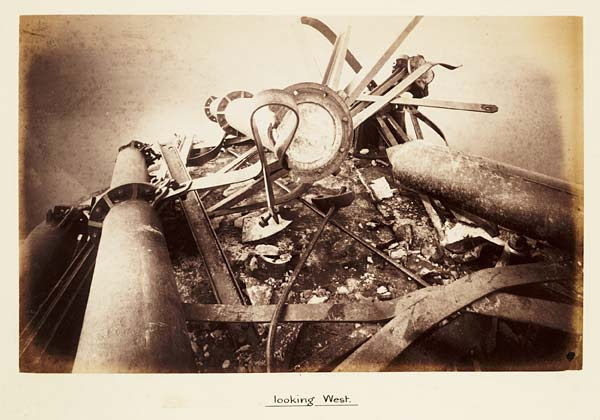

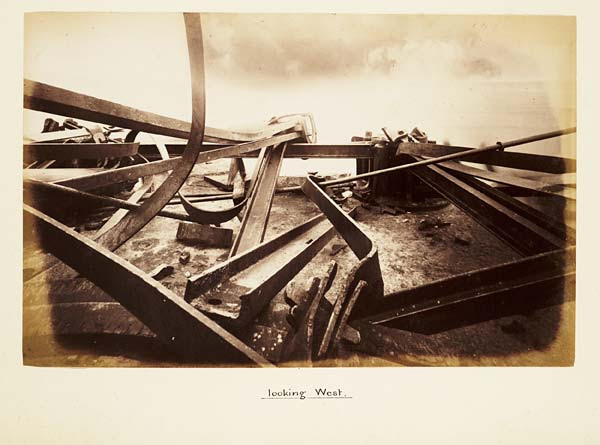
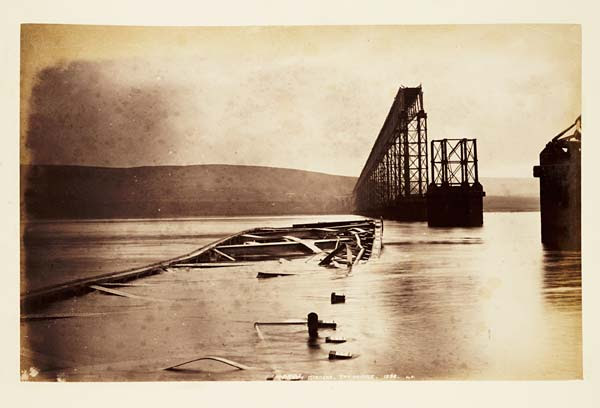
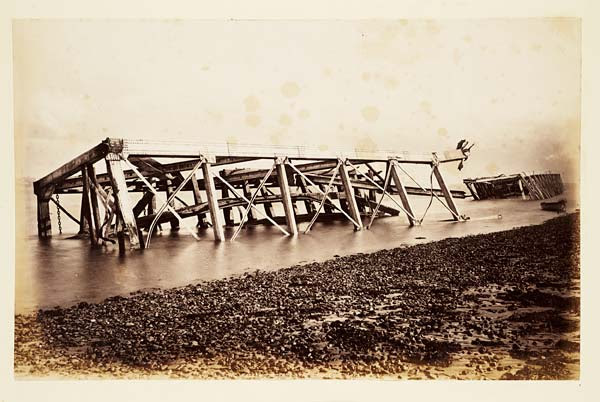
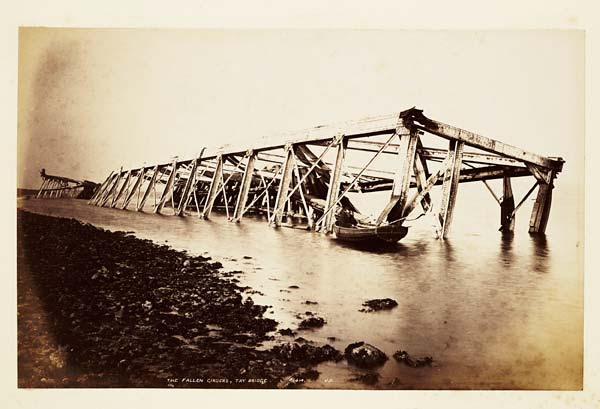
Photos from Tay Bridge enquiry: views of the wrecked piers of the Tay Bridge,
which collapsed because of high winds on 28 December 1879. Commissioned by John Trayner on
behalf of the Board of Trade: photographer unknown, 1880 (National Library of Scotland)
Was the Tay Bridge disaster caused by tornadic waterspouts?

The collapse of the Tay Bridge in 1879: photographer unknown, 1880 (National Library of Scotland)
Weatherwatch: Tay tragedy's new twist: David Hambling, The Guardian, 22 December 2014
The
Tay Bridge disaster of 28 December 1879, subject of a famously bad poem
by William McGonagall, may have been caused by tornadoes.
The wind was blowing hard that night, perhaps as much as a Force 11 gale, bringing down chimney pots and roof slates. The iron girders of the Tay Bridge, opened in June 1878, should have been strong enough to withstand any winds. But a half-mile span of the bridge collapsed just as a train was crossing. The rain plunged into the Tay, killing all 75 people on board.
A court of inquiry ruled that the collapse was due to an “insufficiency of the cross bracing and its fastenings” to withstand the gale.
However, the inquiry did not hear the testimony of one witness, engineer WB Thomson, who reported seeing “two luminous columns of mist or spray”, perhaps 100 metres tall, travelling across the river. The spray from one column struck a nearby house with hissing sound, leaving the windows caked with salt. A second witness, William Robertson, also described the columns.
Researchers at tornado research organisation Torro believe these columns were waterspouts -– tornadoes over water made visible by the water droplets they carry. They believe the impact of one or more tornadoes brought down the bridge after it had been weakened by the wind.
After the disaster rules were introduced requiring new bridges to be built stronger. As McGonagall observed: “For the stronger we our houses do build / The less chance we have of being killed.”
Allen Upward: the story of the waterspout: strength turning inside out

Waterspout close to the shoreline near Batemans Bay, 140 miles south of Sydney: photo by Reuters / NSWRFS / Phil Caminiti, 18 November 2012
The story of the waterspout, as it is told in books, shows it to be a brief-lived tree. A cloud is whirling downwards, and sucking out its whirlpoint toward the sea, like a sucking mouth. The sea below whirls upward, thrusting out its whirlpoint towards the cloud. The two ends meet, and the water swept up in the sea-whirl passes out into the cloud-whirl, and swirls up through it, as it were gain-saying it. . . .
In the ideal waterspout, not only does the water swirl upwards through the cloud-whirl, but the cloud swirls downwards through the sea-whirl. . . .
The ideal waterspout is not yet complete. The upper half must unfold like a fan, only it unfolds all around like a flower-cup; and it does not leave the cup empty, so that this flower is like a chrysanthemum. At the same time the lower half has unfolded in the same way, till there are two chrysanthemums back to back. . . .
It is strength turning inside out. Such is the true beat of strength, the first beat, from which all others part, the beat we feel in all things which come within our measure, in ourselves, and in our starry world. . . .
Allen Upward: from The New Word, written 1901, self-published 1908

Residents view huge waterspout close to the shoreline near Batemans
Bay, 140 miles south of Sydney: photographer unknown, via The Sun, 18 November 2012

Waterspout, seen from Clifton, Woolongong, New South Wales: photo by dirtymouse, 22 April 2007
Waterspouts in the Bahamas Islands: photo by National Oceanic and Atmospheric Administration, n.d.
Tornado waterspout near Cape Formentor, Mallorca: photo by Julian Kupfer, 2006

Waterspout off Singapore coast: photo by Sgyjk, 25 September 2011

Twin waterspouts, Kakaaka Waterfront Park, Honolulu: photo by rubbah slippahs, 2 May 2011

Twin waterspouts, Kakaaka Waterfront Park, Honolulu (last gasp, just before the spout on the left dissipated): photo by rubbah slippahs, 2 May 2011

Waterspout: photo by SICAL808, 2 May 2011

Tromba marina da Caia d'Oro, Solenzara (Corse): photo by azuk, 26 July 2010

Tra cielo e mare (Civitanova, Marche, Italy): photo by F. Fausta, 9 October 2011

A giant waterspout is seen over Hongze Lake in eastern
China’s Jiangsu Province: photo by Yue Mingyou / Rex Features, 29 August 2012

Waterspout, Alanya, Antalya Province, Turkey: photo by rinselsbacher (Ralph Inselsbacher), 11 September 2002


Waterspout, seen from Clifton, Woolongong, New South Wales: photo by dirtymouse, 22 April 2007
Waterspout off the Florida Keys:: photo
by National Oceanic and Atmospheric Administration, 1969
Waterspouts in the Bahamas Islands: photo by National Oceanic and Atmospheric Administration, n.d.
Tornado waterspout near Cape Formentor, Mallorca: photo by Julian Kupfer, 2006

Waterspout off Singapore coast: photo by Sgyjk, 25 September 2011

Twin waterspouts, Kakaaka Waterfront Park, Honolulu: photo by rubbah slippahs, 2 May 2011

Twin waterspouts, Kakaaka Waterfront Park, Honolulu (last gasp, just before the spout on the left dissipated): photo by rubbah slippahs, 2 May 2011

Waterspout: photo by SICAL808, 2 May 2011
Trombe marine a rion antirion (Grèce): photo by Bruno Arnaud, 15 December 2007

Tromba marina da Caia d'Oro, Solenzara (Corse): photo by azuk, 26 July 2010

Tra cielo e mare (Civitanova, Marche, Italy): photo by F. Fausta, 9 October 2011

Waterspouts seen from the air, approx. 1200 feet high, about 40nm north of Vanderlin Island, Gulf of Carpentaria, Northern Territory, Australia: photo by Tony (austr07), 1987; image 27 August 2009





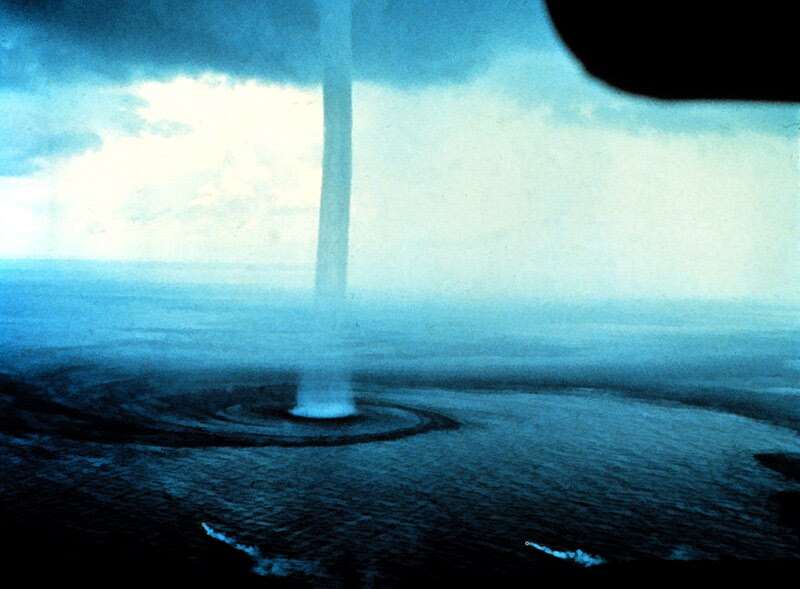






8 comments:
When is William McGonagall going to get a bit of due credit?
Oh, McGonagall. Poor McGonagall. Every time another internet genius declares him the worst poet of all time, a handmedown opinion which has always been easier to pass along than to contest, a tiny thimbleful of blood, stored deep in the dusty cupboard of the heart, springs a leak.
Just because you weren't meaning to be funny doesn't make your poems any the less funny and great, if you're McGonagall.
If you checked out that short video link, you'll note that, toward the end, a descendant, dressed up in her best clothes, sitting in her best fake leather armchair (the one with black masking tape discreetly covering a rip in the armrest, a particularly touching detail for me, because I've had that same chair for almost 50 years, more than once actually carried it on my back, and carefully placed that same bit of home-repair black tape in exactly that same spot, though I can no longer sit in it without being swallowed up forever), tells the interviewer politely but firmly that No, she didn't like the Spike Milligan film about McGonagall, and didn't want to be involved in it, because, in fact, she thought her ancestor was, once again, being mocked, for what she suggested were/are "reasons" having to do with his being of low class, uneducated, and she was quite right, and I felt proud of her.
The stories of McG's (non-, or fantasy-) relations with Queen V are too heartbreaking to think about for long without feeling awful.
Tom, startling images and a haunting story.
I wonder, though, if after a certain point building 'harder houses' makes us more likely to get killed?
Rowan Moore had a fascinating article on the architect of the twin towers. In particular, the question that struck me was: what makes buildings and cities strong? Their opposition to nature?
http://www.prospectmagazine.co.uk/features/minoruyamasaki
billoo,
Very interesting article. Following out the implied proposition, that a Kyoto-style structure -- open, visibly fragile, vulnerable to winds and weather -- might not have simply presented to the world a far less formidable, imposing and dominating symbol of Money and Power (the real twin towers), but might also have seemed a far less effective target (after all, an attack on Humility and Vulnerability would be viewed far differently than an attack on the monolithic citadels of the global power of Capitalism), is a useful thought-exercise.
But of course no such architectural plan could have been sold to New York in the first place. Once the architect said things like "Kyoto" and "unprotected" and "vulnerable" and "open to the winds", there would have ensued a brief period of semi-polite throat-clearing and glancing-at-watches, followed by some sort of conciliatory resolution, along the lines of "Who let this guy in here? -- he must be nuts!", and "Get him out of here right now... give him a broom and a bin on wheels, offer him a sub-janitor position, anything!"
One suspects Mohamed Atta was a shrewd fellow who knew exactly what he was doing. He had done a long and careful study of urban design in his dissertation on Aleppo. He may even -- mirabile dictu! -- have known more about how cities are made, how they work, and how they can be made to fall, than, yes, Rudy Giuliani.
That is a fantastic poem. Also, as someone who is at the mercy of both wind and wave, a darn scary read.
Just the other morning, we woke up to a new shipwreck outside our back door. It looks like they'd just looked to thin a line to hold their anchor -- if we're ever wrecked, it'll be a more spectacular failure of engineering worthy of Wm McGonagall.
Oops, I should pay more attention when I'm typing. The previous post should say, "It looks like they just used too thin a line to hold their anchor."
Nora, that looks like the result of one of these powerful nor'easters we've been having.
Easily strong enough to beach a cute toy boat.
By inserting a bit of actual useful local knowledge into the comments, you've perhaps prevented future lookers from thinking it's some kind of cunning hoax.
I call that a service.
William McGonagall would undoubtedly have thought likewise, and likely would have declaimed upon that thought, in the event the next king tide was slow in arriving.
The boat was gone this morning, dislodging the middle of the three pilings visible in the background as it went. We woke this morning to the gentle knocking of the former piling (now log?) against our hull.
I should write a poem.
Post a Comment